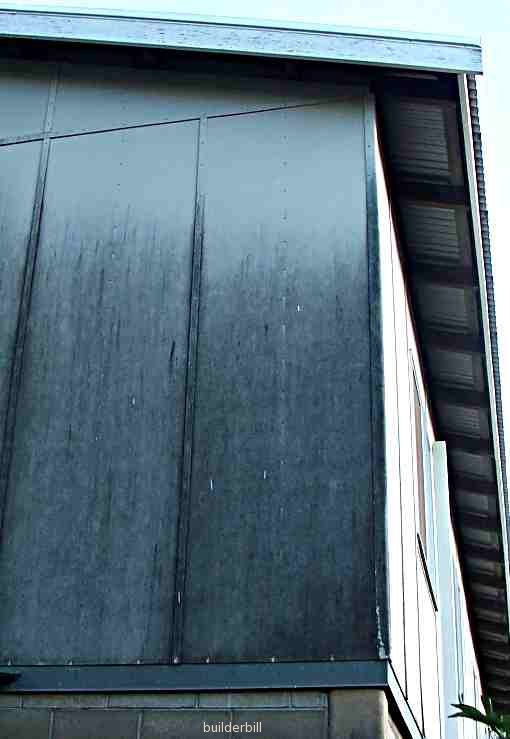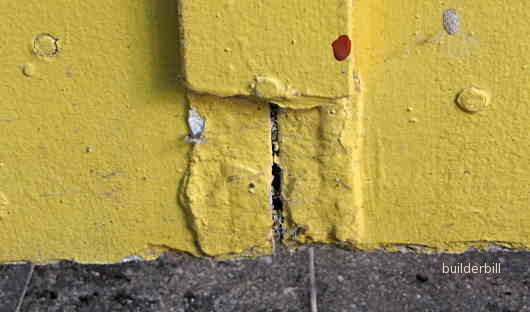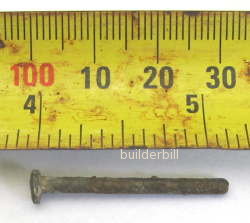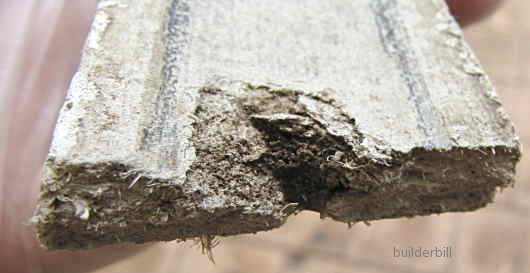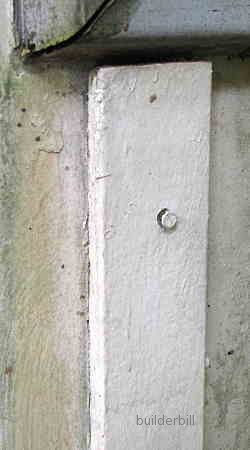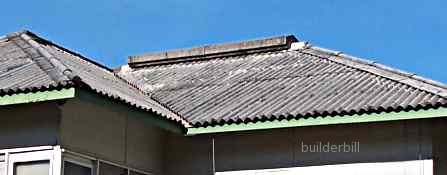 |
|||||||||||||||
Asbestos Containing products in the home, what forms it can take and where it is likely to be.I did Google search for "Asbestos Containing Products" and found many sites that contain lists of a frightening amount of products that ranged from curtains to lamp wicks, welding rods to jointing compounds. One site listed over 3000 and admitted that that wasn't the total. I guess that we will never know the true extent of this noxious substance. So on this page I will list only the main one's that are likely to be causes of concern to homeowners.
Asbestos cement siding, AC or FAC,Fibrous Asbestos Cement sheets.Asbestos cement siding is used on external and internal walls and ceilings, as in the photo above and it can also be found in the typical planked siding form.
The infamous Fibro as it was commonly called are flat cement based sheets reinforced with asbestos fibres. They were by far the most common of the asbestos containing products used in home building.
Cover Battens and external corner moulds are accessory type asbestos containing products that originally always were used in conjunction with Fibro sheets. Internal corner joints were usually covered with two standard cover battens. On internal ceilings and walls the Fibro battens were almost never used. The joints were made with aluminium "H" joint strips and sometimes aluminium internal and external corners. A word of cautionProspective purchasers, intending renovators and handymen should note that many Fibro clad houses have had their battens and corner moulds removed in order to disguise the fact that the cladding is an asbestos containing product. The ones that are simply then patched with some sort of bogging compound are easily spotted. Harder to see are the ones that have simply been covered up with various types of sheeting. This in itself may not be a problem, except that when they come to do any renovations they will have to factor in the extra cost involved in safely working with and disposing the offending material. Wet area Fibrous Asbestos Cement sheets. Trade name "Tilux" Manufactured in Australia by James Hardy and Co.Used in the wet areas, Bathroom, WC, laundry and kitchen splash backs. This pre finished/painted coloured wet area sheeting is 6mm thick and comes in 900 and 1200 wide and usually 1800 and 2100 high sheets. Usually in mottled patterns and using aluminium trims. Once again a word of caution, many times this asbestos containing product has been covered up with ceramic tiles by renovators.
AC or FAC,Fibrous Asbestos Cement corrugated roof and wall sheets.Called "Super Six" or sometimes (later on) "Fibrolite" these asbestos containing products along with their accessories, were used for roof sheets mainly, but they were also used for industrial walls. Another very popular application was for garden fencing. The Super Six sheets were stood up vertically into say a 450 deep trench, bolted at the joins, a capping piece was added and the trench back filled. No posts or rails were needed. Asbestos cement sheets thicker than Fibro or siding materials.
Other less common asbestos containing products.
Never discount the possibility that previous owners of the home brought into the house or garden some asbestos containing product that was not really a part of the house or building material. Not found it yet? Try this FAST SITE SEARCH or the whole web |
Hire Equipment  Furniture Fittings - Architectural Hardware - Electronic Locking Systems - Technical Hardware BuilderBill sponsorship Asbestos related pages.NEW -Asbestos Glossary Introduction to asbestos in house constructionAsbestos Containing Products How to identify asbestos. Asbestos Danger Asbestos Management Asbestos Removal Reader's QuestionsAsbestos houseAsbestos house renovation. Asbestos Tilux. Asbestos-cladding Asbestos - Disclaimer.This is a highly complex and stringently regulated field. I am not a scientist, I am not a government spokesperson or anyone with any authority to talk or give professional advice on the subject in your area. What I am is a retired builder with a large amount of practical experience fixing fibrous asbestos cement products and then later removing them. In 1995 I was issued an asbestos removal licence (43133) by the Northern Territory Work Health Authority, and did many asbestos removal jobs, complying with Australian Work Health (OH&S) Regulations and the NOHSC National Code Of Practice For The Safe Removal Of Asbestos. I hope you get something of value out of these pages, but a word of caution, at the last count I get visitors from 132 different countries, there is no way that I can give specific advice that would comply with the regulations in your country, state, district or local area. In other words, the onus is on YOU to check out the regulations where you live, and comply with them. If you have any doubts get advice from a licensed person IN YOUR AREA. |
||||||||||||||
|
|
|||||||||||||||
|
Please Note! The information on this site is offered as a guide only! When we are talking about areas where building regulations or safety regulations could exist,the information here could be wrong for your area. It could be out of date! Regulations breed faster than rabbits! You must check your own local conditions. Copyright © Bill Bradley 2007-2012. All rights reserved. |
|||||||||||||||
